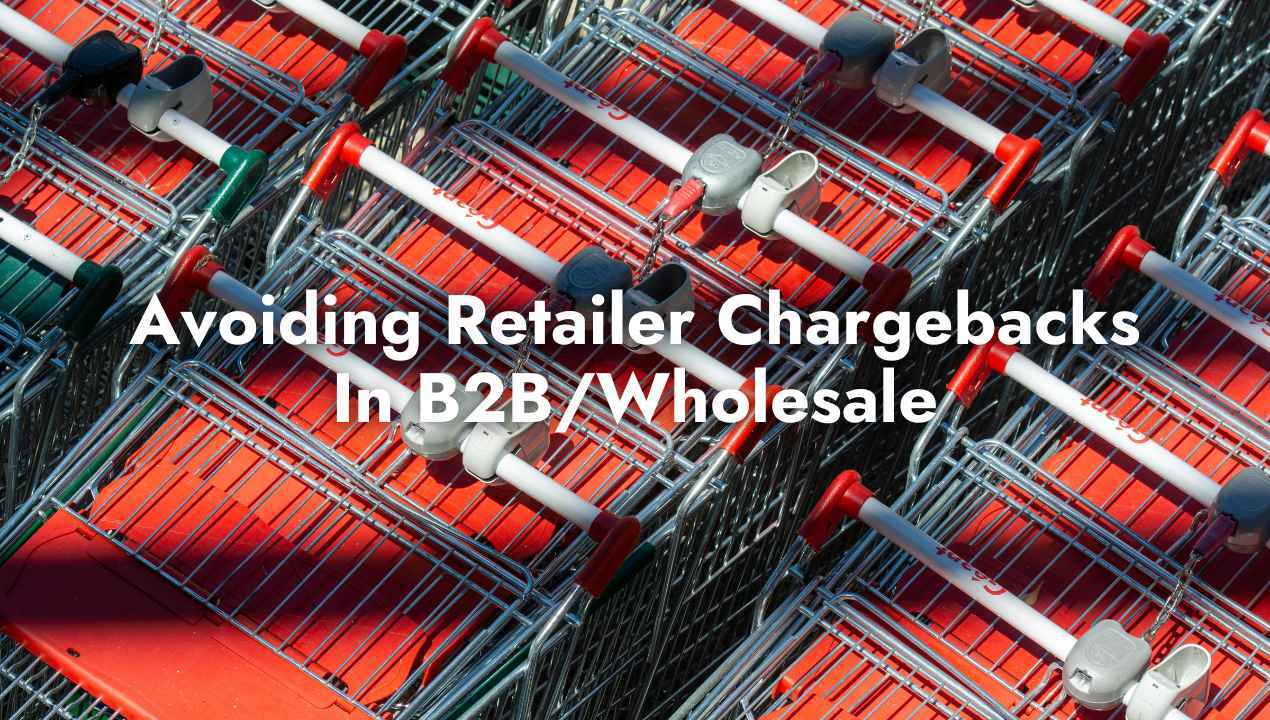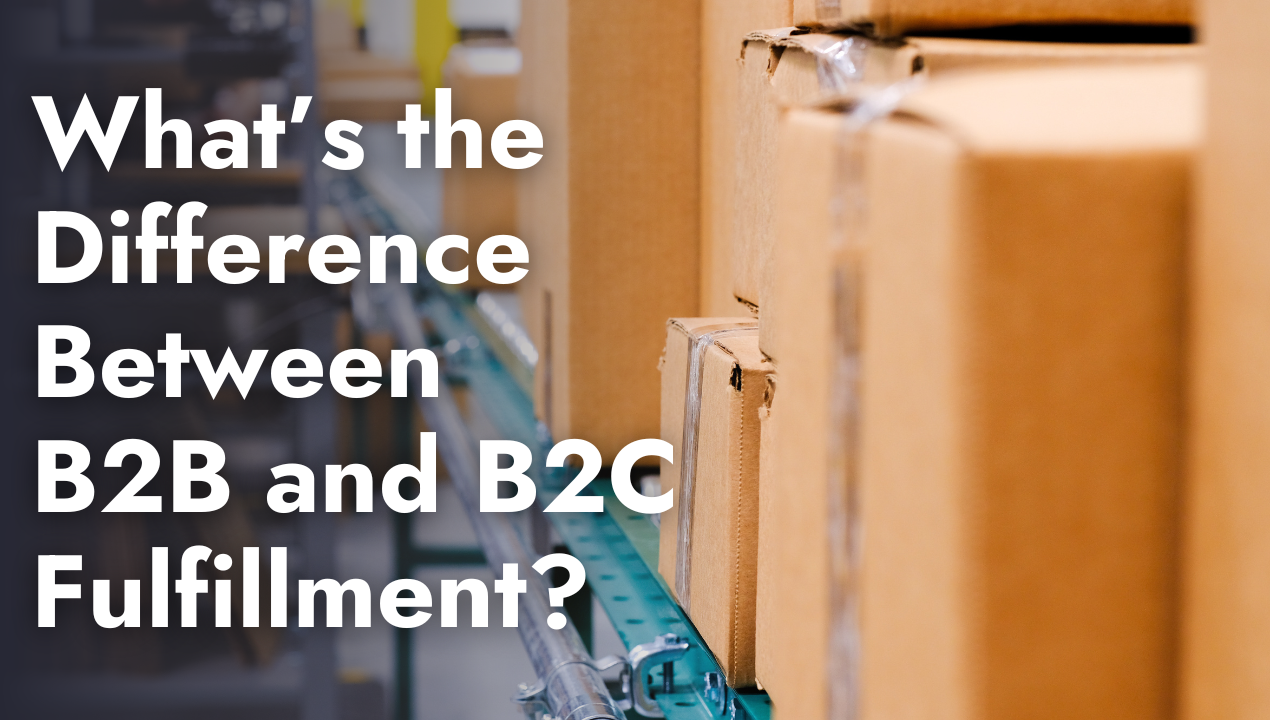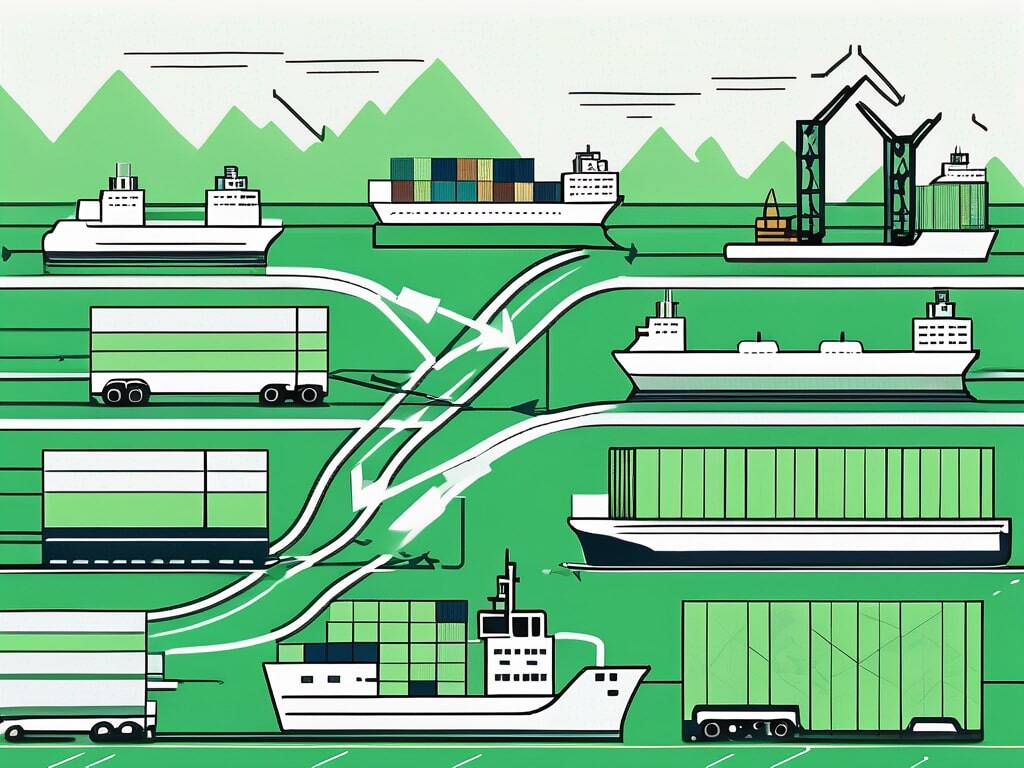Share this
Avoiding Retail Chargebacks In B2B/Wholesale Fulfillment
by Rin Mosher on Sep. 20, 2024

Getting your products into retail stores is something to be celebrated, but also approached with diligence. Compliance can be a real headache for ecommerce businesses new to large-scale B2B/wholesale logistics. Chargebacks and similar fines may stem from minor missteps in meeting retailer requirements yet have a major impact on both profit margins and relationships with retailers. The good news? Penalties are avoidable with the right approach.
In this article, we’ll walk you through some straightforward strategies to dodge chargebacks and keep your operations running smoothly – while keeping your bottom line intact and your retailer relationships strong.
What are Chargebacks In Retail?
A chargeback is a financial penalty retailers impose on suppliers when they fail to meet the agreed-upon operational standards. These fees allow B2B/wholesale buyers, or retailers, to recoup the costs of inefficiencies caused by errors while incentivizing future compliance from their ecommerce suppliers.
Chargebacks are standard in the B2B and wholesale industry. Major players like Walmart and Target have extensive vendor compliance guides detailing their chargeback policies. Penalties for violations are typically percentage-based, where a predefined percentage of the rejected order's value is added as a fee to the supplier's invoice.
Chargebacks can range from minor fees for small discrepancies to substantial penalties for major violations. The specific amounts and triggers vary by retailer, but they often fall within the range of 1% to 5% of the order value. Walmart, for example, currently issues 3% chargebacks on late or missing deliveries in its On-Time in Full program.
The complexity of retailer requirements coupled with the high stakes of non-compliance makes chargeback management a hefty job for ecommerce businesses. This reality is especially daunting for growing companies breaking into the B2B space for the first time.
Types of Retailer Chargebacks
The B2B order fulfillment and shipping process is difficult because it's both high-volume and case-specific. Individual retailers have different expectations on everything from pallet stacking to delivery windows, so there's plenty of room for error – and many opportunities to incur a chargeback.
Here's an overview of the main types of chargebacks imposed by retailers today:
Shipping and Delivery Chargebacks
Mistakes made during shipping or delivery are one of the most common causes of retail chargebacks. Both early and late deliveries are major inconveniences for retailers; early order arrivals can disrupt warehouse operations and inventory management, while late deliveries can throw off a retailer's entire supply chain schedule. Other shipping-related chargebacks include incomplete shipments, overshipments, and incorrect carrier usage.
Packaging and labeling Chargebacks
Retailers like Walmart and Target are very particular about how their inventory orders are packaged and labeled. But these guidelines don’t exist just to be difficult – uniform packaging and labeling help to streamline receiving, stocking, and inventory management processes. When suppliers deviate from these standards, it creates inefficiencies that cost retailers time and money.
Common packaging and labeling chargebacks include:
- Penalties for incorrect or missing UPC codes, SKUs, or barcodes that prevent seamless scanning at intake
- Charges for documentation errors, such as missing bills of lading, incomplete packing slips, or inaccurate Advanced Shipping Notices (ASNs)
- Fines for failing to follow pallet stacking or wrapping guidelines, which could lead to damaged goods during transit or difficulties in warehouse storage
- Improper packaging, such as using non-approved materials or methods, particularly if the retailer has sustainability requirements
- Penalties for shipping products in quantities that do not match the agreed-upon case pack sizes
Electronic Data Interchange (EDI) and Documentation Chargebacks
Virtually every major retailer requires its suppliers to use Electronic Data Interchange (EDI) for order processing and communication. EDI streamlines the exchange of business documents like purchase orders, invoices, and shipping notices. However, errors in EDI transactions or missing documentation can lead to significant chargebacks.
Common EDI and documentation-related chargebacks include:
- Fees for not confirming receipt of purchase orders within specified timeframes
- Penalties for submitting invoices with incorrect pricing, quantities, or missing information
- Fines for failing to provide timely and accurate Advanced Shipping Notices (ASNs), which are important for warehouse preparation and receiving
- Charges for errors in electronic purchase orders, invoices, or other EDI documents that disrupt the retailer’s processes
Product Quality Chargebacks
Product quality chargebacks occur when a retailer receives items that do not meet the expected standards. These issues can arise from damaged goods during transit, manufacturing defects, or products not functioning as intended.
For example, a shipment of electronics may be returned if a portion of the items arrive broken, or a batch of apparel may be rejected if stitching defects are discovered. Quality-related chargebacks can be costly, as they often involve entire shipments being delayed, rejected, or returned.
Compliance Chargebacks
Compliance chargebacks are issued when shipments fail to meet specific regulatory or contractual requirements. Common reasons for compliance chargebacks include incorrect labeling, missing or incomplete documentation, non-compliance with safety standards, or failure to meet packaging specifications.
For example, a retailer may reject a shipment if the labeling doesn't include required safety warnings, or if the packaging does not comply with environmental regulations. Like product quality chargebacks, compliance chargebacks can result in financial penalties and additional delays as shipments are corrected or returned.
What Damage Could a Retailer Chargeback Do to Your Business?
It’s no secret that retailer chargebacks are something to avoid. No business wants to see its hard-earned profits drained by something preventable. But the impact goes beyond just losing money.
A chargeback isn’t just a financial hit – it’s wasted time and effort. Every rejected shipment represents hours spent on picking, packing, and prepping that order. Now, your team has to handle the returns management of those goods, taking time to either fix or break down the pallets, which can also take up valuable space in the warehouse.
Then, there’s the inventory issue. Imagine you’ve just shipped a large order to Walmart and start restocking, assuming that inventory is out the door. But then the entire shipment gets returned because of a compliance problem. Suddenly, you’ve got more stock than you expected, which ties up capital and warehouse space you hadn’t planned for.
Retailers have specific guidelines for a reason. Their operations depend on vendors following those requirements to keep everything running smoothly. Missing those standards disrupts their supply chain, causing delays and added costs that they won’t overlook for long.
If these compliance issues pile up, it can damage your relationship with the retailer. Over time, you might notice fewer orders coming your way, or even see your products relegated to less visible spots in their stores.
How to Avoid Retailer Chargebacks In B2B/Wholesale
When it comes to retailer chargebacks, an ounce of prevention is worth a pound of cure. You’re much better off taking proactive measures against potential causes of routing guideline violations than reactively adapting after they’ve already had an impact.
In the following sections, we go over best practices capable of making all the difference in mitigating long-term risk and maintaining strong relationships with B2B customers.
Read Routing Guidelines In Full
Routing guidelines outline every packing and shipping rule you’re expected to follow when working with individual retailers. These guidelines can be extensive, but they’re worth reading from beginning to end and revisiting whenever updates are released. Staying up to date ensures you are familiar with both essential rules like label placement and more nuanced policies and exceptions. The more knowledgeable you are, the less likely you’ll be to inadvertently break these guidelines.
Invest In Fulfillment Accuracy
Studying routing guidelines is only the first step. Putting that knowledge into action with proactive measures to ensure guidelines are always followed is key to avoiding chargebacks. While some retailers may offer a warning or opportunity to resolve issues, repeated mistakes can escalate quickly into costly penalties or damaged relationships. There’s limited room for error, so it’s important to aim for precision from the start.
A robust quality control system can and should be multi-layered, consisting of checks at every step of the ecommerce fulfillment process. Utilize technology where possible – barcode scanners, automated weight checks, and digital checklists can significantly reduce human error.
Implement a system of double-checks, where one employee verifies the work of another. The four-eyes principle can catch mistakes that might slip through individual inspections.
Remember to tailor these processes to each retailer's unique guidelines, as what works for one may not suffice for another.
If that sounds like too much responsibility to assume in-house, consider working with a third-party logistics (3PL) company. Service providers specializing in B2B and wholesale fulfillment already have the infrastructure, trained staff, and protocols in place to compliantly pack such large-scale orders.
Plus, outsourcing operations to an expert saves you from having to ongoingly manage your own B2B fulfillment team. That means more time and resources to put towards further expanding your network of retail partners.
Ongoingly Monitor Compliance
Promoting diligence during picking, packing, and shipping isn't enough to guarantee it. Regular audits and performance reviews are essential to maintaining high compliance standards. Implement a system to track and analyze chargeback data, identifying patterns or recurring issues.
A dedicated compliance officer or team may be helpful in ensuring changes are communicated and implemented across operations. They can also conduct internal audits, simulate retailer inspections, and provide ongoing training to keep your team up-to-date with the latest compliance requirements.
It's also important that your business' warehouse management system (WMS) is up for the tall task of B2B/wholesale fulfillment. A good software solution can be programmed to enforce specific packing rules, generate compliant labels and documentation, and even optimize order fulfillment based on each retailer's preferences.
Conduct Post-Chargeback Analysis
If a chargeback does occur, it’s important to treat it as a learning opportunity. Conduct a thorough investigation into the root cause of the chargeback. Was it a simple human error, a systemic issue, or a misunderstanding of the retailer's guidelines? Once identified, develop and implement corrective actions to prevent similar incidents in the future.
Consider creating a chargeback response team that can quickly address issues as they arise. This team should be well-versed in each retailer's specific requirements and be able to communicate effectively with the retailer to resolve disputes or explain any misunderstandings.
Additionally, maintain open lines of communication with your retail partners. If you notice a sudden increase in chargebacks or encounter a particularly challenging guideline, don't hesitate to reach out for clarification or feedback. Many retailers are willing to work with vendors to improve compliance and reduce chargebacks, as it ultimately benefits their operations as well.
Shipfusion Clients Don't Have to Worry About Chargebacks
At Shipfusion, we’ve built our fulfillment solution to take the headache out of retailer compliance. Our tech-enabled warehouses, seamless ecommerce platform integration, and dedicated account managers ensure that your B2B and wholesale orders are always accurate, on time, and fully compliant with every retailer’s routing guidelines.
With our integrated EDI system, you can rest easy knowing that every document—whether it’s a purchase order, invoice, or shipping notice—is processed smoothly and without error, reducing the risk of costly chargebacks.
With Shipfusion, you’re not just avoiding chargebacks—you’re gaining a trusted partner who scales with your business and takes care of the logistics, so you can focus on growth.
Ready to stop worrying about chargebacks and start focusing on scaling your business?
Contact one of our fulfillment experts today and let us handle the logistics while you drive your business forward.
Share this
You May Also Like
These Related Articles

Unpacking the Difference Between B2B and B2C Order Fulfillment

7 Common Wholesale Fulfillment Errors and How to Prevent Them

What to Know Before Working with a B2B Shipping Company
- October 2025 (1)
- September 2025 (6)
- August 2025 (8)
- July 2025 (16)
- June 2025 (22)
- May 2025 (27)
- April 2025 (27)
- March 2025 (26)
- February 2025 (26)
- January 2025 (34)
- December 2024 (16)
- November 2024 (22)
- October 2024 (22)
- September 2024 (27)
- August 2024 (9)
- July 2024 (8)
- June 2024 (5)
- May 2024 (8)
- April 2024 (7)
- March 2024 (6)
- February 2024 (6)
- January 2024 (5)
- December 2023 (3)
- November 2023 (3)
- October 2023 (5)
- September 2023 (4)
- August 2023 (2)
- July 2023 (1)
- June 2023 (4)
- March 2023 (2)
- October 2022 (1)
- September 2022 (5)
- August 2022 (4)
- July 2022 (7)
- June 2022 (4)
- May 2022 (4)
- April 2022 (6)
- March 2022 (2)
- February 2022 (1)
- January 2022 (3)
- December 2021 (2)
- November 2021 (4)
- October 2021 (2)
- September 2021 (5)
- August 2021 (4)
- July 2021 (4)
- June 2021 (3)
- May 2021 (2)
- April 2021 (3)
- March 2021 (3)
- February 2021 (3)
- January 2021 (2)
- December 2020 (4)
- November 2020 (2)
- October 2020 (4)
- September 2020 (2)
- July 2020 (5)
- June 2020 (4)
- May 2020 (2)
- April 2020 (2)
- March 2020 (4)
- February 2020 (1)
- December 2019 (1)
- May 2018 (1)
- March 2018 (2)
- February 2018 (3)
- January 2018 (3)
- November 2017 (3)
- July 2017 (4)
- March 2017 (3)
- February 2017 (5)
- January 2017 (3)
- December 2016 (4)
- November 2016 (6)
- October 2016 (6)
- October 2015 (1)
- September 2015 (1)
- June 2015 (3)
- May 2015 (3)
- August 2014 (1)
- July 2014 (1)
- March 2014 (1)
- February 2014 (1)
.png?width=3334&height=468&name=Shipfusion_Logo%20Color%20Light%20(1).png)
.png?width=2850&height=400&name=Shipfusion_Logo%20Color%20Light%20(1).png)